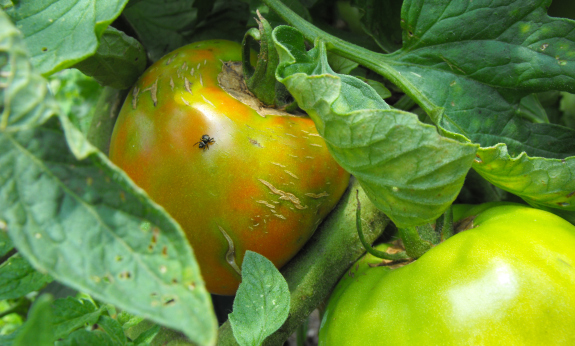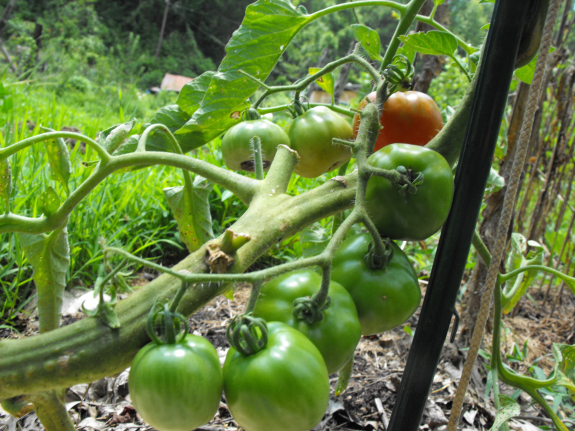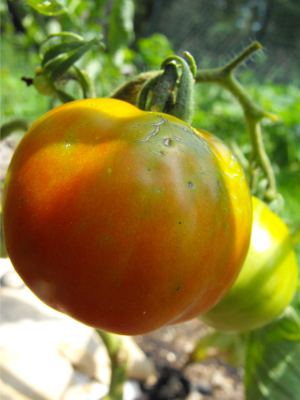
First tomato

I've had my eye on our
oldest tomato plant for weeks. (This is
the one that volunteered in our lemon tree's pot this winter and which
I set out in the garden on April 21, babying
through cold spells.)
The plant swelled up huge fruits, then
kept swelling more and more fruits, none of which changed color.
Last week, I saw the tiniest hint of red on the oldest fruit, and
crossed my fingers. But I was looking in entirely the wrong spot
for our first tomato.

 Wednesday
morning, I caught a glimpse of
orange from the tomato bed on the opposite side of the naughty
butternuts. I
peered closer and saw a fruit nearly ripe!
Wednesday
morning, I caught a glimpse of
orange from the tomato bed on the opposite side of the naughty
butternuts. I
peered closer and saw a fruit nearly ripe!
A few years ago when we
splurged on seeds for several heirloom
tomatoes, I picked out Stupice as a very cold-tolerant and early
variety. Sure enough, it looks like the Stupice tomato will
probably be the first one on our plate, perhaps by the end of the week.
To be fair, though, this
mini-experiment doesn't prove that tomatoes started in a cold frame and
set out at the frost free date ripen just as quickly as those started
indoors and transplanted out three weeks earlier. I have
absolutely no clue what variety my volunteer belongs to, and I suspect
it might have been the seed of a storebought tomato that made it into
our neighbor's compost and thus to us. At this point, though, I'm
at the who-cares stage --- as long as I get a sun-ripened tomato
shortly, experiments will fly out of my head.
Want more in-depth information? Browse through our books.
Or explore more posts by date or by subject.
About us: Anna Hess and Mark Hamilton spent over a decade living self-sufficiently in the mountains of Virginia before moving north to start over from scratch in the foothills of Ohio. They've experimented with permaculture, no-till gardening, trailersteading, home-based microbusinesses and much more, writing about their adventures in both blogs and books.
Want to be notified when new comments are posted on this page? Click on the RSS button after you add a comment to subscribe to the comment feed, or simply check the box beside "email replies to me" while writing your comment.

The first picture isn't the stupice, but the second and third ones are. They definitely fit your size description --- a bit of a halfway house tomato, not really cherry, but not really full size.
I've been reading up on tomato ripening (more on that later), and discovered that the orangey-red color I see sometimes isn't a variety trait. It's the result of the heat wave --- when temperatures reach about (I think it was) 86 F, the color of the resulting tomato turns from red to orange.